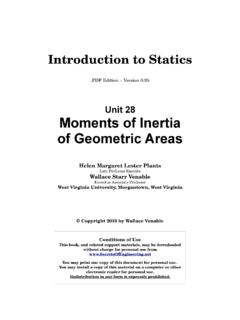Transcription of Unit 30 Moments of Inertia of Masses - statics
1 Introduction to Edition Version 30 Moments of Inertia of MassesHelen Margaret Lester PlantsLate Professor EmeritaWallace Starr VenableEmeritus Associate ProfessorWest Virginia University, Morgantown, West Virginia Copyright 2010 by Wallace VenableConditions of UseThis book, and related support materials, may be downloaded without charge for personal use may print one copy of this document for personal use. You may install a copy of this material on a computer or other electronic reader for personal in any form is expressly 30 Moments of Inertiaof MassesFrame 30-1 Introduction This unit will deal with the moment of Inertia of mass, which should hardly be a new concept to you, since you have encountered it previously in math, and has many simularities to moment of Inertia of area.
2 We will therefore pass rather lightly over its more mathematical aspects and concentrate instead on the actual arithmetical juggling involved in finding the Moments of Inertia of both simple goemetric shapes and composite moment of Inertia of area, we might argue that "this isn't statics ," but it is usually covered in statics courses as preparation for dynamics. The basis for this is that, to work problems dealing with rotation and plane motion of bodies, it is mandatory that we either have, or be able to determine, correct values for the Moments of Inertia of first section of this unit will summarize the mathematical concept of moment of Inertia of to the next response to preceding frame No responseFrame 30-2 Mathematical Statement By definition, the moment of Inertia of an element of mass dM with respect to any plane (or axis)
3 Is the product of the mass of the element and the "square-of-the-distance" from the element to the plane (or axis).*So we see that:About the xz-plane, dI xz = y 2 dM About the x-axis, dIx = ( y2 + z2 ) dM(a.) About the xy-plane, dIxy = _____(b.) About the yz-plane, dIxz = _____(c.) About the y-axis, dIy = _____(d.) About the z-axis, dIz = _____*Comment: Don't worry about the physical significance of a moment of Inertia about a plane -- it hasn't any; it is merely a mathematical artifice!Correct response to preceding frame(a.) About the xy-plane, dIxy = z2 dM(b.) About the yz-plane, dIxz = x2 dM(c.)
4 About the y-axis, dIy = ( x2 + z2 ) dM(d.) About the z-axis, dIz = ( x2 + y2 ) dMFrame 30-3 Review You have previously learned to define the moment of Inertia of an area with respect to a given axis (for example, the x-axis) as The moment of Inertia of a mass with respect to the same axis is In both cases, however, the element must be chosen so that the entire element is thesame _____ from the response to preceding frame distanceFrame 30-4 Choice of Element Check those cases in which the element is properly chosen for the corresponding response to preceding frame(a), (b), (f)
5 In the other cases all parts of the element are not equidistant from the 30-5 Choice of Element Sketch two elements of mass which might be used to find the moment of Inertia of the cone about the y-axis by using Sketch two elements which could be used to find the moment of Inertia of the parabaloid about the x-z plane by using Correct response to preceding frameFrame 30-6 Limits After a proper element of mass has been selected, the next step is to establish the proper limits for the integral I = 2 parabaloid shown is composed of a homogeneous material of density . The element mass is then given by dM = dv = dx dy dz and the square of its distance from the z-axis will be 2 = x 2 + y 2 The moment of Inertia about the zaxis will thus beSupply the correct limits for the integral exactly as response to preceding frameIf your limits are correct, skip to Frame 30-12; if not, go to the next 30-7 Limits In integrating with respect first to x, we are simply expanding theelement in the "x-direction.
6 " The limits are the locations where the expanding element pierces the surface of the Show the element expanded in the Which of the following are the proper limits?Correct response to preceding frameFrame 30-8 Limits The variable radius of the small circle can be expressed in terms of z asBy means of the Pythagorean theorem, find f (y,z) (defined on the lower drawing).f(y,z) = _____Correct response to preceding frameFrame 30-9 Limits The result of the integration of dx inwas to let the differential cube expand in the x-direction into a next integration will let the rod expand in the y-direction until it is again limited by the "surface.
7 "1. Draw the resulting The correct limits on y areCorrect response to preceding frameFrame 30-10 Limits Supply the limits for the integration of dy infor the figure response to preceding frameFrame 30-11 Limits The final integration consists of stacking up the disks obtained by the two previous integrations until the parabaloid is filled in. Complete the response to preceding frameThe height of the parabaloid, h, is equal to ka 30-12 Limits The method you have just completed -- that of visualizing the expansion of the element due to each integration in turn -- may be used on any multiple integration problem and will reduce the problem of finding limits to a problem in geometry.
8 A good choice for the order of integration results in less work than a poor choice. Consequently, you may actually save time by sketching elements for more than one order and choosing the order that looks to the next response to preceding frame No responseFrame 30-13 Transition The methods of multiple integration may be well known to you, and you may have a few tricks of your own for shortening the work. If you want a more thorough treatment, you will find it in the nearest text on integral calculus; complete with a nice (?) selection of problems. You will not need it to complete this you need to find the moment of Inertia of a mass bounded by complicated mathematical surfaces, multiple integration is the tool you must use.
9 Most engineering problems, however, deal with bodies which can be built up out of simple geometric shapes. The next section of this unit will deal exclusively with these will take you roughly 60 minutes to reach the next transition, so take a short break before going to the next frame. When you return, GO-GO--GO!Correct response to preceding frame No responseFrame 30-14 Geometric Forms The simplest geometric form is a rectangular parallelepiped. Assume the parallelepiped shown to be of constant density . Now let's test your mathematical virtuosity by finding its moment of Inertia about the x-axis, which just happens to pass through the mass-center of the body.
10 (As also do the y and z axes.)(a.) Make a sketch of an appropriate element.(b.) Set up your integral, but do not integrate response to preceding frameFrame 30-15 Geometric Forms Now that you have the appropriate integral expression for I x , namelyComplete the = _____Correct response to preceding frameFrame 30-16 Geometric Forms For a homogeneous parallelpipedWhat is the mass of the body? M = _____Write I x in terms of the mass. Ix = _____Correct response to preceding frame Frame 30-17 Geometric Forms For the homogeneous mass shownDoes the dimension parallel to the x-axis appear in the expression for I x ?








